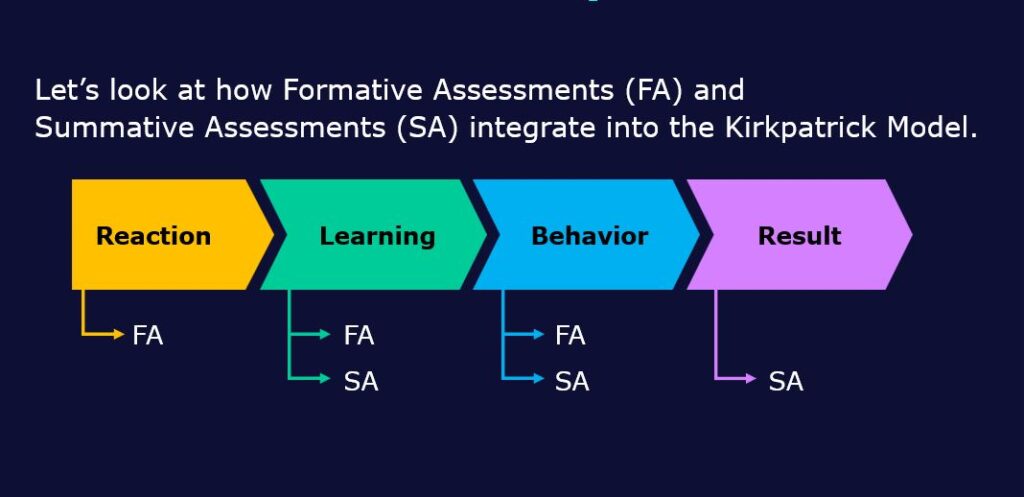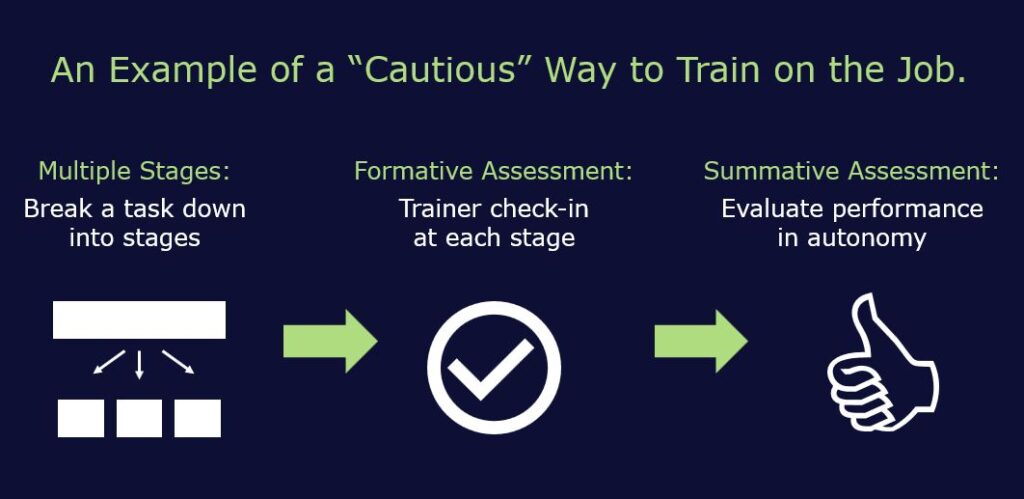Goal:
This whitepaper aims to explain how the two main types of assessments (formative and summative assessments) integrate into the Kirkpatrick model in synergy.
Formative and Summative Assessments
In the field of training and development, there are two main types of assessments with different focuses:
- Formative (such as practice)
- Summative (such as final exam)
Formative assessments work like “practice” opportunities. In addition to practices, they also give the learners feedback to help them self-correct, reflect, and improve. They also let the trainers know how a learner is doing in the midst of training.
Summative assessments work like “final exams”. While they also help the learners self reflect, their main purpose is to provide a final set of data about how the training went.
The best practice is to have BOTH formative and summative assessments in a training program—with as many small formative assessments as possible throughout the training.
Assessments in Different Contexts: Knowledge/Understanding, Performance in Practice, and Performance on the Job
For Knowledge & Understanding assessments, you can easily implement small practices and knowledge checks before giving your learner a final test.
For Performance in Practice, one of the ways to apply formative assessments is to break the task down into smaller challenges and give them immediate feedback on how they are doing. After they have demonstrated a pattern of success, you can give them a summative assessment.
For Performance on the Job, we want to avoid mistakes altogether. Therefore, a coach/trainer should watch over the learners in their first few performance attempts and give them feedback if/when they are about to make a mistake. This can work as a type of formative assessments. After they become consistently successful, the coach/trainer can back off to give the learners more independence and only evaluate the end results as summative assessments.
Integrating Formative and Summative Assessments with the Kirkpatrick Model

Let’s look at how assessments integrate into the Kirkpatrick model.
For Kirkpatrick’s Area 1: Reaction
Formative Assessments can happen during a training’s implementation.
For example, we can frequently gather feedback from the trainees regarding some adjustable aspects, such as the training time, duration, tempo, the availability of in-person support, etc.
We can also gather feedback on other areas, such as the training’s design, content, etc. Although some of these may not be immediately adjustable, they can at least help us make adjustments for the next group of learners.
For simplicity’s sake, let’s view this type of reaction-related assessments as formative assessments because they are ongoing and help us make adjustments.
For Kirkpatrick’s Area 2: Learning
When it comes to learning, we recall from earlier that Blooms Taxonomy outlines 6 levels of mastery:
- Knowledge
- Understanding
- Application
- Analysis
- Synthesis
- Evaluation
At a minimum, most corporate training requires level 1~3, so the trainees can at least apply the training in action. Therefore, let’s take a closer look at this scenario.
For Bloom’s
- knowledge and
- understanding
(in layman’s term: head knowledge), the formative assessments will usually look like “knowledge check” practices, such as eLearning pop-quizzes with immediate feedback on correct/wrong answers.
For the summative assessment, it could be a cumulative test given to the learners AFTER the formative assessments.
For Bloom’s level 3: application, there are many assessment options, one of which is to ask the trainees to apply their learning in a “practice environment”, where it is safe to make mistakes. There will usually be a trainer (1 or more) in the room.
For formative assessments, the trainer will first model the task as a demonstration, then guide the trainees to do the same, step by step.
At each step, the trainer will frequently check on the trainees’ performance and provide immediate feedback—until everyone is applying what they’ve learned correctly.
For Summative Assessments, the trainees will perform the task with autonomy (without any assistance), and the trainer will evaluate the performance. If anyone is not doing things correctly, the trainer might schedule additional coaching afterwards.
Next, we will be changing the environment from a “practice” setting to a “work” setting on the job.
For Kirkpatrick’s Area 3: Behavior
Kirkpatrick’s “Behavior” means the trainees would apply their training in a real work setting on the job.
For formative assessments, one of the methods involves the trainer asking the trainees to check in at key steps before proceeding. This not only lets the trainees get plenty of feedback for improvement, it can also decrease the chance for errors.
For summative assessment, the trainer will evaluate the trainees’ performance data in regards to the trained subject.
Two Tips:
- Just because the trainees are able to apply, it does not automatically mean they are also “willing” to apply. Being “able” and “willing” are both part of Kirkpatrick’s Behavior. If a trainee is not applying what’s learned, use the training data to figure out the root cause. This is also why it’s a good idea for the trainer to work with the trainees’ supervisors to stay informed of the trainees’ performance on the job.
- It is very common (and helpful) for the trainees’ supervisor or more experienced peers to step in as trainers or additional support coaches for on the job training. If you choose to do this, your trainer can function more as a supporter to assist them.
For Kirkpatrick’s Area 4: Result
Kirkpatrick’s “Result” is, by nature, a summative assessment. It examines the final impact the training program has made on the organization.
Because it takes place AFTER the training program has completed, it is not a formative assessment. However, it does offer important insights to help us continuously improve our training program for the future trainees.

